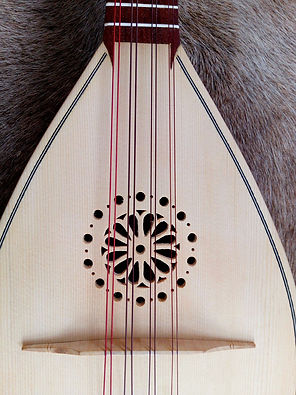
_modificato.jpg)
Cittern
Of European origin, this instrument belongs to the classification of chordophones, in the family of long-handled lutes. It developed between the tenth and twelfth centuries, first from the Lute and later from the Citola. Its maximum use is found in Renaissance music. It is characterized by a pear-shaped case, double choir strings that can vary from four to six and the fixed frets are made of bone.


Hurdy Gurdy
Medieval instrument originating in western Europe, of the family of chordophones with rubbed strings. There are a lot of different shapes, and, over time, an increasing number of strings. This instrument has characterized music from the Middle Ages onwards and its diffusion was mainly due to its completeness, given the presence of melody strings, drones and the " trumpet", thanks to which it is possible to give greater rhythm to what is played.
_modificato.jpg)
_modificato.jpg)
Scheitholt
(Scheitholz)
This version is a reinterpretation and an extension of the Scheitholt (also called Scheitholz) illustrated by the writer M.Pretorius. Of the chordophonic family, it descends from the monochord and is the ancestor of numerous instruments such as Epinette, Dulcimer, Zither, ... Detailed evidence of this can be found from the beginning of the fourteenth century, and remains in great use even during part of the Renaissance period.


Symphonia -
Cantiga de Santa Maria
It is a primordial version of the hurdy-gurdy, therefore belonging to the family of chorded chordophones. Of rather small size, we have the first evidence of this at the beginning of the thirteenth century. This is a reinterpreted reconstruction based on an illustration of the Cantigas de Santa Maria manuscript.
_modificat.png)

Rebec
Of the family of chordophones, Ribeca, although supposedly of Arab origin, is very widespread in the courts of Europe between the twelfth and sixteenth centuries. Recent discoveries and studies have brought to light very similar instruments also of Scandinavian origin and preceding the Arab expansion, dated around the ninth/tenth century. Generally it was played with a bow, but iconographic sources show us styles of execution also plucked. Characterized by its particular shape, it has only three strings and the harmonic case is made from a single hollowed piece.





Fiedel (Vielle)-
Codex Manesse
Reconstruction of an arched Viella from the first half of the 14th century, based on illustrations from the manuscript Codex Manesse (Heidelberger Liedehandschrift).
The body is made from a single block of wood. Several details are only interpretations given the lack of detailed representations or finds. The Soundholes are taken from another medieval manuscript.

Citole
The citole is a medieval, plucked bowl-neck lute with four (less often three and five) strings or choirs, which was particularly widespread from the 13th to the middle of the 14th century.
The body is carved from one piece of wood and the frets are made from gut.
We can found some illustrations for example in the Cantiga de Santa Maria.











